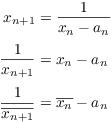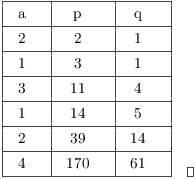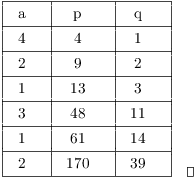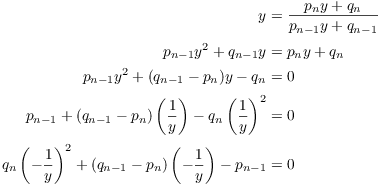We've seen that quadratic irrationals correspond to periodic
continued fractions. A periodic continued fraction may repeat
eventually (like ![]() ) or repeat from the start (like
) or repeat from the start (like ![]() ). In this section, I'll
consider the second case.
). In this section, I'll
consider the second case.
Definition. A continued fraction of the form
![]() is purely periodic.
is purely periodic.
I'll derive a criterion for a quadratic irrational to have a purely
periodic continued fraction. It is a result of Galois from 1829
([1]). Recall that if ![]() is a quadratic
irrational, its conjugate is
is a quadratic
irrational, its conjugate is
![]()
Theorem. Let ![]() be a quadratic
irrational. The continued fraction for x is purely periodic if and
only if
be a quadratic
irrational. The continued fraction for x is purely periodic if and
only if ![]() and
and ![]() .
.
Proof. (![]() ) Suppose
) Suppose ![]() and
and ![]() . Using the
general continued fraction algorithm and properties of conjugates, I
have
. Using the
general continued fraction algorithm and properties of conjugates, I
have

Note that ![]() for
for ![]() . But
. But ![]() , so
, so ![]() . Thus,
. Thus, ![]() for
for ![]() .
.
Claim: For all ![]() ,
,
![]()
I'll prove the claim using induction. First, ![]() , so by
assumption
, so by
assumption ![]() .
.
Assume that ![]() .
Then
.
Then ![]() gives
gives ![]() , so adding
, so adding ![]() gives
gives

Since the middle inequality shows ![]() , I have
, I have
![]()
This proves the claim by induction.
Now

Using the claim, I have

This inequality says that ![]() , and also that
, and also that ![]() is an integer which differs from
is an integer which differs from ![]() by less than 1. It follows that
by less than 1. It follows that
![]()
Since x is a quadratic irrational, its continued fraction is periodic. Thus, there are indices i and j such that
![]()
Hence,
![$$\eqalign{ \overline{x_i} & = \overline{x_j} \cr \noalign{\vskip2pt} \left[-\dfrac{1}{\overline{x_i}}\right] & = \left[-\dfrac{1}{\overline{x_j}}\right] \cr \noalign{\vskip2pt} a_{i - 1} & = a_{j - 1} \cr \noalign{\vskip2pt} a_{i - 1} + \dfrac{1}{x_i} & = a_{j - 1} + \dfrac{1}{x_j} \cr \noalign{\vskip2pt} x_{i - 1} & = x_{j - 1} \cr}$$](purely-periodic-continued-fractions37.png)
Thus, ![]() implies
implies ![]() . Continuing to reduce
indices in this way, I eventually obtain
. Continuing to reduce
indices in this way, I eventually obtain
![]()
Therefore,
![]()
Hence, x is purely periodic.
(![]() ) Suppose x is
a quadratic irrational that is purely periodic, so
) Suppose x is
a quadratic irrational that is purely periodic, so ![]() , where
, where ![]() . Note
that
. Note
that ![]() . I have
. I have
![]()
Hence,
![]()
So
![]()
The quadratic function ![]() has x and
has x and ![]() as its roots. I already know
as its roots. I already know ![]() ; I need to show
; I need to show ![]() . It's enough
to show that f has a root between -1 and 0: Since that root can't be
x, it must be
. It's enough
to show that f has a root between -1 and 0: Since that root can't be
x, it must be ![]() .
.
First, ![]() .
Next,
.
Next,

Then ![]() and
and ![]() implies that there's a root
between -1 and 0 by the Intermediate Value Theorem. As noted above,
that root must be
implies that there's a root
between -1 and 0 by the Intermediate Value Theorem. As noted above,
that root must be ![]() .
.
Thus, ![]() and
and ![]() .
.![]()
For example, ![]() satisfies
satisfies ![]() and
and ![]() . Its
continued fraction is
. Its
continued fraction is
![]()
On the other hand, ![]() , but
, but ![]() does not lie between -1 and 0. Its
continued fraction is
does not lie between -1 and 0. Its
continued fraction is
![]()
To motivate the next result, consider the following example.
Example. (a) Compute the numerators and
denominators of the convergents for ![]() .
.
(b) Compute the numerators and denominators of the convergents for
![]() .
.
(a)

(b)

Look at the numbers in the last two rows of the tables in the last example. They suggest the following result.
Theorem. Consider the continued fractions
![]()
Let ![]() and
and ![]() denote the numerator and denominator of the
denote the numerator and denominator of the
![]() convergent for x.
convergent for x.
Let ![]() and
and ![]() denote the numerator and denominator of the
denote the numerator and denominator of the
![]() convergent for y.
convergent for y.
Then:
(a)
![]()
(b)
![]()
Remark. By reversing the roles of x and y, it also follows that
![]()
Proof. (a) We'll induct on n. For ![]() , consider the convergents tables
for
, consider the convergents tables
for ![]() and
and ![]() :
:

Then
![]()
![]()
The result holds for ![]() .
.
Assume that the result holds for n (that is, that it holds for a
fraction with ![]() terms and its
reverse). I need to prove the result for
terms and its
reverse). I need to prove the result for ![]() --- that is, for the fractions
--- that is, for the fractions
![]() and
and ![]() , I have
, I have
![]()
Note that the primed p's and q's are for ![]() , not for
, not for
![]() .
.
I have

I'll apply the induction hypothesis to ![]() and
and ![]() . Note that
. Note that
![]() and
and ![]() are the same for
are the same for ![]() and
and ![]() .
However, the p's and q's for
.
However, the p's and q's for ![]() and for
and for
![]() are different,
so I'll use double-primed p's and q's for
are different,
so I'll use double-primed p's and q's for ![]() . With this
understanding, the induction hypothesis gives
. With this
understanding, the induction hypothesis gives
![]()
Then using the last two equations, I have
![$$\eqalign{ \dfrac{p_{n + 1}}{p_n} & = a_{n + 1} + \dfrac{1}{\left(\dfrac{p_n}{p_{n - 1}}\right)} \cr \noalign{\vskip2pt} & = a_{n + 1} + \dfrac{1}{[a_n, \ldots a_1, a_0]} \cr \noalign{\vskip2pt} & = [a_{n + 1}, a_n, \ldots a_1, a_0] \cr \noalign{\vskip2pt} & = \dfrac{p_{n + 1}'}{q_{n + 1}'} \cr}$$](purely-periodic-continued-fractions107.png)
Similarly,

By induction,
![]()
So
![]()
This proves the result for ![]() , so the result holds for all
, so the result holds for all ![]() by induction.
by induction.
(b) Recall that
![]()
It follows that ![]() and
and
![]() are
in lowest terms. But
are
in lowest terms. But ![]() and
and
![]() are convergents of a continued fraction, so they're
in lowest terms as well.
are convergents of a continued fraction, so they're
in lowest terms as well.
![]() is an equality between fractions in lowest
terms, so
is an equality between fractions in lowest
terms, so ![]() and
and ![]() . Likewise,
. Likewise, ![]() is an equality between fractions
in lowest terms, so
is an equality between fractions
in lowest terms, so ![]() and
and ![]() .
.![]()
This result relates a finite continued fraction ![]() and its
"reverse"
and its
"reverse" ![]() . The next
result (also due to Galois) considers the relationship between the
purely periodic continued fractions
. The next
result (also due to Galois) considers the relationship between the
purely periodic continued fractions ![]() and
and ![]() .
.
Theorem. Let ![]() be a purely periodic quadratic irrational. Then
be a purely periodic quadratic irrational. Then ![]() is purely periodic, and
is purely periodic, and
![]()
Proof. The idea is to show that ![]() and
and ![]() are roots of the same quadratic
equation. This implies that they are conjugates.
are roots of the same quadratic
equation. This implies that they are conjugates.
Let ![]() be the
be the
![]() convergent of x. Then
convergent of x. Then
![]()
The convergents algorithm gives

Let
![]()
Let ![]() denote
the
denote
the ![]() convergent of
y. The convergents algorithm gives
convergent of
y. The convergents algorithm gives
![]()
By the preceding theorem, ![]() ,
, ![]() ,
, ![]() , and
, and ![]() . So
. So

Thus, x and ![]() are roots of
the quadratic
are roots of
the quadratic ![]() , so they must be conjugates:
, so they must be conjugates:
![$$\eqalign{ \overline{x} & = -\dfrac{1}{y} \cr \noalign{\vskip2pt} y & = -\dfrac{1}{\overline{x}} \cr \noalign{\vskip2pt} -\dfrac{1}{\overline{x}} & = [\overline{a_n, a_{n - 1}, \ldots a_1, a_0}] \cr} \quad\halmos$$](purely-periodic-continued-fractions148.png)
[1] É. Galois, Démonstration d'un théoréme sur les fractions continues périodiques, Annalles de mathématiques 19 (1828), 294--301.
Copyright 2019 by Bruce Ikenaga